Thinking ‘omnichannel communication strategies’ sound complicated? You’re not the only one.
Trust us, you’ll be glad that you took the time to understand what it means—over half of UK shoppers have reported that omnichannel benefits, like the option to order online and return items in-store, would increase their loyalty.
We’ve broken omnichannel communication strategies down into simple terms in this blog post so that you can understand and experience the difference they make for yourself.
imail comms. For cost-effective yet powerful solutions.
Table of Contents
What is Omnichannel Communication?
Omnichannel Communication vs. Multichannel Communication
Examples of Successful Omnichannel Strategies
Why Are Omnichannel Communication Strategies Important?
Key Components of Successful Omnichannel Communication
Benefits of Omnichannel Communication
How to Execute an Omnichannel Communication Strategy
The Power of Customer Communication Management Software (CCM)
Frequently Asked Questions (FAQ’s)
What is Omnichannel Communication?
‘Omni’ means ‘all’ — think of the more well known word ‘omnivore’. An omnivore eats all types of food, and an omnichannel communication strategy communicates with customers across all channels.
But what are channels?
Channels are any way that you communicate with a customer. This might be online through your social media, your website, or your email marketing campaigns. It could also be offline, when a customer visits your store, or when you send them direct mail.

What are the 4 C’s of Omnichannel?
The 4 C’s of omnichannel marketing, based on Bob Lauteron’s original 4 C’s of marketing, are:
- Consistency: Providing a uniform experience across all channels.
- Convenience: Ensuring easy access and interaction for customers.
- Customer-Centricity: Focusing on the customer’s needs and preferences.
- Communication: Maintaining clear and effective communication across all platforms.
Omnichannel Communication vs. Multichannel Communication
In contrast to multichannel communication strategies, which also cover more than one channel, omnichannel communication strategies connect all channels together (remember that ‘omni’ means ‘all’ whereas ‘multi’ just means ‘many’.)
The purpose of this is to provide a consistent customer experience, so that if a customer sees a product they like online, for instance, they can trust that it’ll be available in store. If the product was out of stock, the website would be updated because the website and the store are connected. Omnichannel strategies also use customer data insights to gain valuable insights into customer behaviour and improve their experience with the company.
A multichannel communication strategy focuses less on the customer experience and more on getting the company’s message to the customer through using multiple channels, which aren’t necessarily connected.
Both can lead to a higher overall customer lifetime value. Which you use depends on your specific goals. It’s worth noting, however, that using an omnichannel communication strategy can take a multichannel communication strategy further by really understanding the customer and their needs.
Related: Omnichannel vs Multichannel: What Are The Benefits & Key Differences?
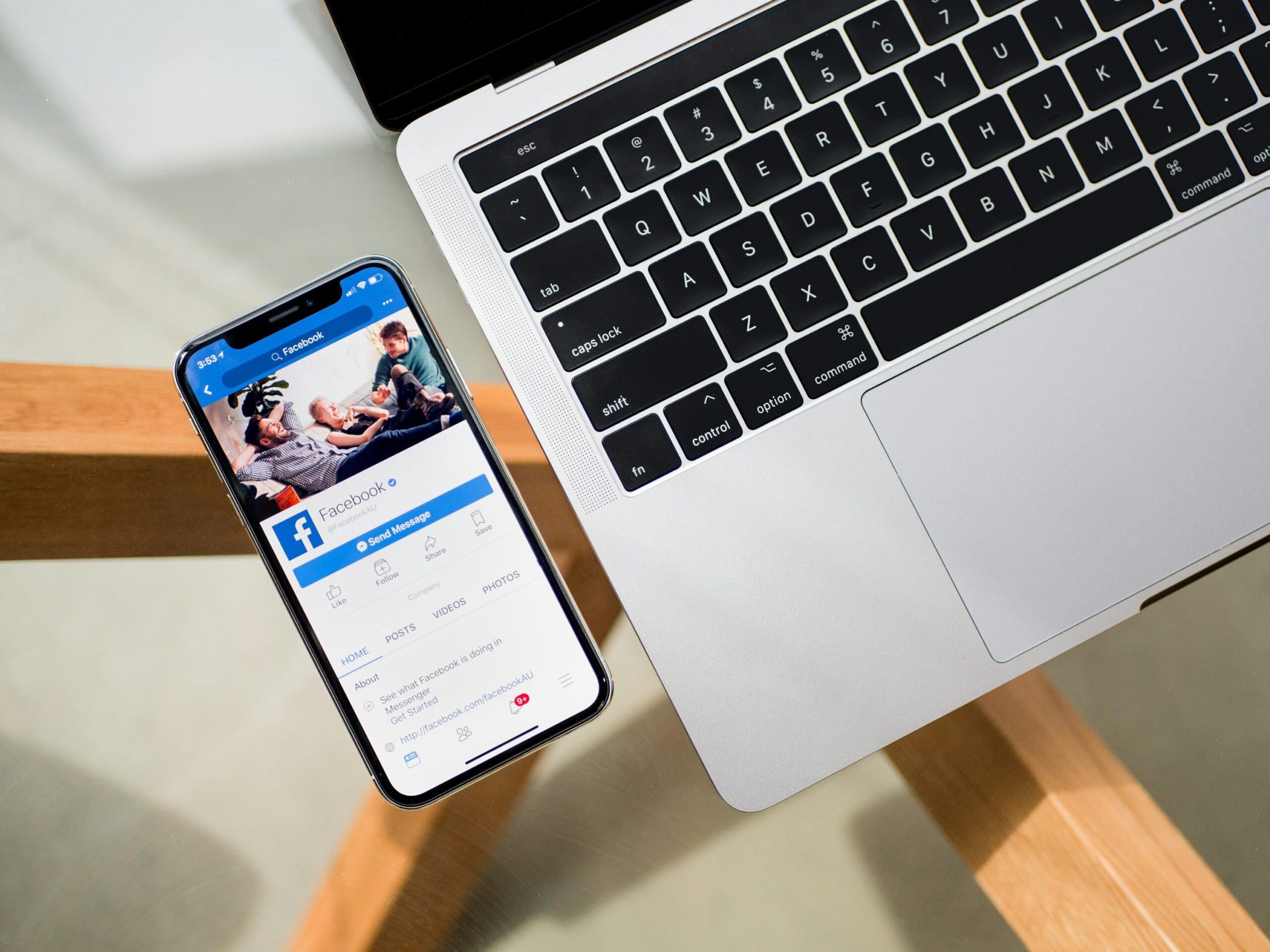
Examples of Successful Omnichannel Strategies
- Starbucks: Starbucks excels with its loyalty programme, which is integrated across mobile app, website, and in-store experiences. Customers can check their rewards, reload their cards, and order ahead, ensuring a seamless interaction regardless of the channel.
- Disney: Disney provides a cohesive experience from start to finish. Through the My Disney Experience app, visitors can plan their trip, book tickets, and even find their way around the park. The integration continues in the park with MagicBands, which serve as hotel keys, park tickets, and payment methods.
- Sephora: Sephora integrates its in-store and digital experiences through its app and website. Customers can use the app to find products, read reviews, and access tutorials, then visit the store for a personalised consultation, with their preferences and previous purchases seamlessly synced.
Why Are Omnichannel Communication Strategies Important?
Omnichannel communication strategies are important for meeting customer expectations. By integrating various communication channels, you can provide a consistent experience that makes your customers feel valued and understood.
For example, imagine a customer starting a purchase on your website, receiving order updates via email, and getting customer service support for the specific order that they made through social media.
With an omnichannel strategy, all these interactions are connected, so the customer feels recognised and valued at every touchpoint.
According to Microsoft, companies that create strong omnichannel communication strategies see 91% higher year-over-year customer retention rates than companies that don’t. This highlights the significant impact of a well-executed omnichannel strategy on customer loyalty.

Key Components of Successful Omnichannel Communication
What makes an omnichannel strategy successful?
Following Your Customers’ Needs
Your messages should be consistent across all platforms and tailored to your customers’ needs. By using data smartly, you can ensure every interaction feels personal and relevant, helping to build a stronger connection with your audience.
For example, imagine a customer starts an order on your website for a new laptop but gets interrupted and doesn’t complete the purchase. Later, they visit your store to check out the laptops in person. With omnichannel communication, the sales associate can see that the customer had an incomplete online order and can assist them in picking up where they left off, ensuring they don’t have to start the process all over again.
This makes the shopping experience much easier and more convenient for the customer, showing that you value their time and preferences.
Salesforce reports that 70% of customers feel this connection is an important part of winning their business.
Strong and Consistent Branding
Keeping your design and branding consistent across all channels is important. Whether your customers engage with you via email, social media, or direct mail, they should always recognise your brand instantly. This consistency builds trust and makes your brand more memorable.
Using Unified Data for Identity Resolution
Identity resolution is the process of connecting data from various customer interactions across multiple channels to give you a complete view of each customer. This helps you personalise messages more effectively, track customer journeys, and make informed decisions to enhance their experience.
For example, let’s say a customer interacts with your brand through email, social media, and your mobile app. By integrating data from these channels, your automated software notices that they often click on social media posts related to outdoor activities and frequently purchase camping gear. With this comprehensive view, you can personalise your messages by sending them targeted promotions for new camping products.
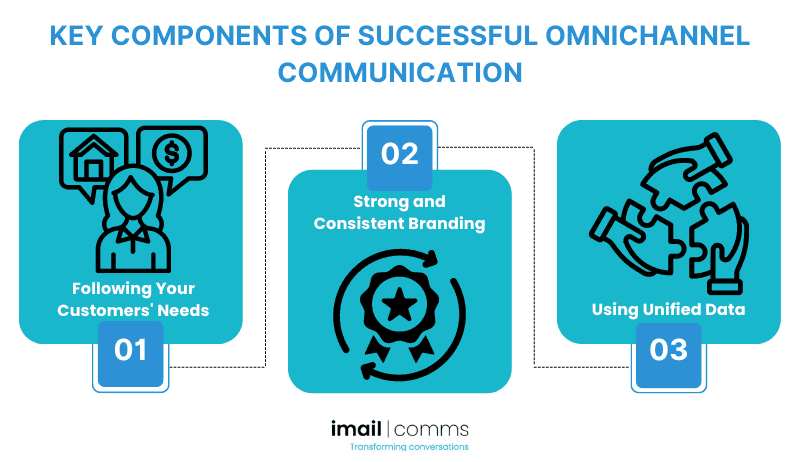
Benefits of Omnichannel Communication
We’ve already touched on some of the benefits of omnichannel communication. But how else can it help your business?
Keeping Customers Engaged with Regular Interactions
Regular, meaningful interactions across various channels ensure your brand remains relevant and accessible, encouraging customers to stay connected and continue their relationship with your brand.
As a result, they are more likely to recommend your products or services to others, driving organic growth and expanding your customer base. Ultimately, these interactions not only strengthen customer relationships but also contribute to long-term success and profitability for your brand.
Boosting Satisfaction Through Integrated Support
What does integrated support mean? Think about a customer starting a support chat on your website about an issue with a product. They need to leave before the issue is resolved, so they call the support hotline later on. With an integrated support system, the phone representative can see the previous chat history and pick up right where the conversation left off. The customer doesn’t have to explain the problem again, making the process quicker and less frustrating.
This seamless transition between channels ensures that customers receive consistent and efficient support, no matter how they choose to contact you.
Increasing ROI with Targeted Strategies
Omnichannel communication allows you to collect and integrate data from multiple sources, providing a comprehensive view of customer behaviour and preferences. With this information, you can identify which channels and strategies are most effective in reaching and engaging your audience. By focusing your marketing efforts on these high-performing areas, you can allocate your budget more efficiently, avoiding wasted resources on less effective tactics.

How to Execute an Omnichannel Communication Strategy
In this step-by-step guide, we’ll take you through how to take a thorough approach to your omnichannel communication strategy.
Related: How To Create A Successful Omnichannel Strategy
1. Map Out Your Current Communication Channels
Start by mapping out all the channels your business currently uses to interact with customers. This includes everything from social media and email to direct mail and in-store communications. Understanding your existing landscape is the first step in creating a cohesive strategy.
2. Analyse Customer Engagement Patterns
Analyse which channels your customers engage with the most. This insight allows you to focus your efforts on the most effective channels, ensuring that you reach your audience where they are most active.
3. Set Branding and Design Guidelines
As we’ve mentioned, it’s important that whether your customers are reading an email or a social media post, they get the same sense of who you are.
4. Gather Customer Preference Data
Use data to understand your customers better and personalise your communications. Collecting data from various touchpoints allows you to tailor your messages to individual preferences and behaviours, creating a more personalised and satisfying customer experience.
5. Communicate When It Matters
Timeliness is key in omnichannel communication. Make sure your messages reach your customers when they are most relevant. Whether it’s a reminder, an offer, or important information, timely communication enhances customer engagement and satisfaction, and gives your strategies a better chance of success.

6. Establish KPIs
Define key performance indicators (KPIs) for each communication channel to measure effectiveness. This helps you understand which channels are performing well and which need improvement. Setting clear KPIs allows for better management and optimisation of your communication strategy.
7. Keep Data Collection Consistent
Ensure that data collection methods are standardised across all channels. This standardisation makes it easier to integrate and analyse data, providing a comprehensive view of customer interactions and behaviours.
8. Align Your Teams
Align your marketing, sales, and support teams to use the same data. This ensures that all customer-facing departments are on the same page, providing a seamless experience for the customer and avoiding miscommunications.
9. Track Engagement Using Identity Resolution
As we touched on earlier, identity resolution involves combining data from all the different ways customers interact with your brand to create a single, cohesive view of each individual. By implementing these techniques, you can accurately track their activities, fully understand their journey with your brand, and provide more personalised and impactful communications.
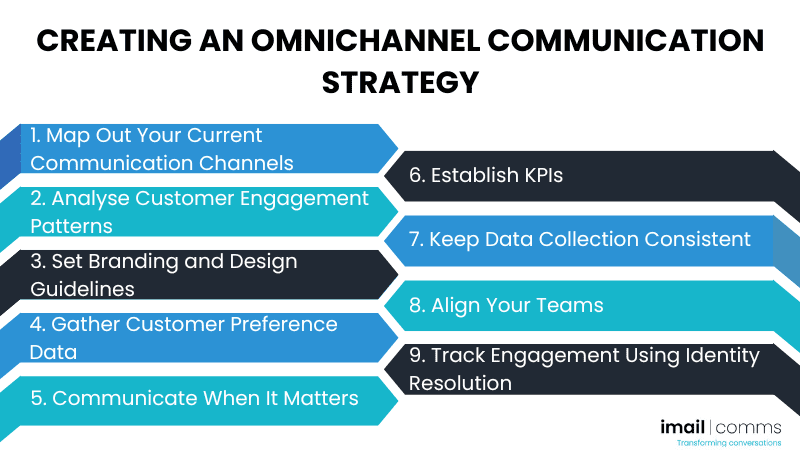
Channels To Use In Your Omnichannel Strategy
Let’s go through each channel you can use in your omnichannel communication strategy to ensure that you’re not missing any.
- In-app messaging is a powerful tool for engaging users directly within your application. It allows for personalised, timely interactions that can enhance user experience and drive engagement.
- Email remains a cornerstone of digital communication, offering a reliable and versatile channel for delivering personalised messages, updates, and promotional content directly to your customers’ inboxes.
- Social media platforms enable you to engage with your audience in a more informal and interactive way. They’re perfect for brand building, customer support, and real-time updates.
- SMS provides a direct and immediate way to reach customers. It’s ideal for sending time-sensitive information, reminders, and promotional offers.
- Live-chat on your website or app offers real-time customer support. By addressing customer concerns promptly, live-chat provides instant resolutions to queries without the need for calls or emails.
- Chatbots can handle routine inquiries and tasks around the clock, freeing up human resources for more complex issues.
- Push notifications are effective for re-engaging users and providing timely updates. They help keep your audience informed and engaged with your app or services.
- Direct mail complements digital channels by providing physical reminders of your brand, promotions, or updates, adding a personal touch that can enhance engagement and recall.
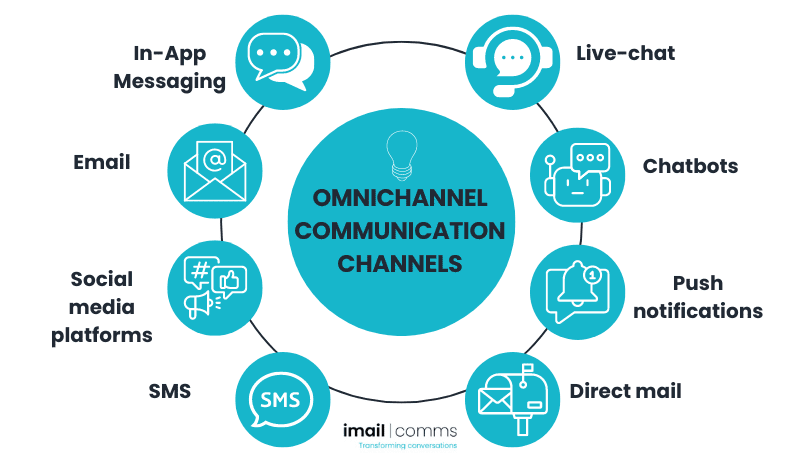
The Power of Customer Communication Management Software (CCM)
The human element of any strategy is important. But software like Customer Communication Management Software (CCM), can give you the tools you need to get in front of the competition.
Using this software takes your omnichannel strategy to the next level. An all-in-one platform like ours ensures consistent communication across all channels, reducing confusion and increasing customer satisfaction scores by 25%.
With pre-built templates, you can save up to 40% of your time, making customer interactions happen faster. Our software is designed to be easy to use by everyone—and we mean everyone, not just the tech-savvy people in your company.
Ready to experience CCM for yourself?
Elevate Your Strategy With CCM
Frequently Asked Questions (FAQ’s)
More questions on omnichannel communication? No problem!
Take a look at our frequently asked questions section below or get in touch with a member of our team for more guidance. With over a decade of experience, we’ll give you full confidence in your customer communications.
What channels should you focus on for an omnichannel approach to communication?
In your omnichannel communication strategy, it’s important to use a mix of channels to cover all bases. Let’s go through these again as a recap.
In-app messaging lets you engage users directly with personalised, timely interactions. Email is still a go-to for updates and promotions, whilst social media offers a fun, interactive way to build your brand and support customers. SMS is great for quick, direct communication and live chat provides real-time help on your website or app. Chatbots can handle routine questions anytime, and push notifications help keep users engaged with timely updates. Finally, direct mail adds a nice personal touch with physical reminders of your brand and promotions.
What is an omnichannel messaging strategy?
An omnichannel messaging strategy is another way of referring to an omnichannel communication strategy. It involves creating a cohesive communication approach that spans multiple channels and ensures that all customer interactions are unified and personalised, providing a fully connected experience. This strategy includes consistent branding, personalised content based on customer data, and timely messages delivered through the preferred channels of the customer, such as email, social media, SMS, and in-app notifications.


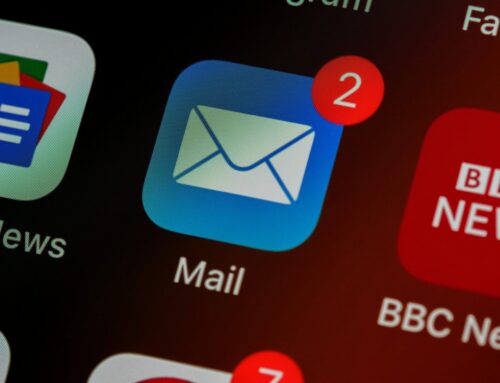
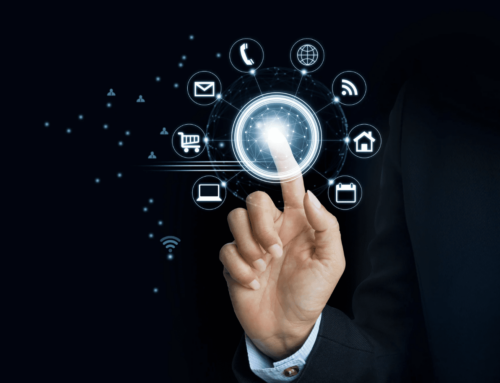
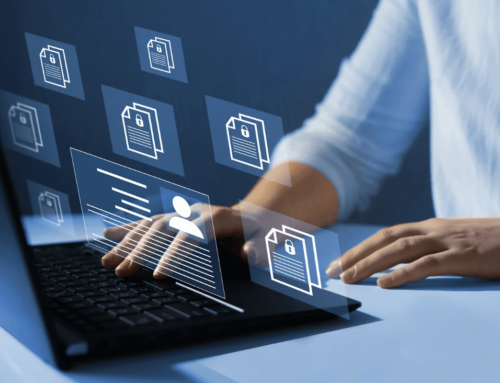

Leave A Comment
You must be logged in to post a comment.